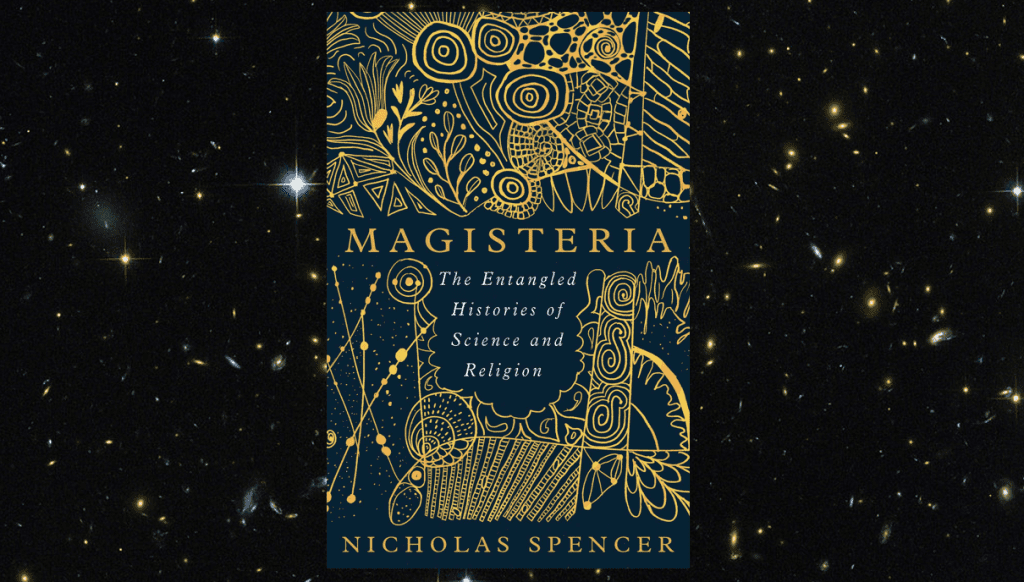Review by Andrew Brown
Nicholas Spencer’s Magisteria is a book that will change your understanding of both science and religion. Its central message is a paradox: there can’t be a single history of science and religion, because neither word has historically meant what it seems to mean now — nonetheless, here is another history of the two and of their interactions.
“Scholarship has fragmented the history of science and religion in lots of way, not least by pointing out that, historically speaking, there weren’t really any such things, such as we would understand them today, as science and religion,” he writes.
Both “religion” and “science” are in this sense constructs of the late 19th century, and they are concepts driven by social and political need rather than by any analysis of the practices involved. The words sort the world into two tribes in ways that really aren’t helpful to understanding it.
Anyone following along with the backlash against the New Atheism will be familiar with some of the story and in particular the invention of the war against science and religion by a 19th-century anti-Catholic polemicist for whom the Galileo story was a wonderful example of the suppression of truth by power. There are still many people who believe that myth.
Spencer does a good job of retelling that story with nuance and wit: “Galileo was a prodigious experimenter in an age before the experiment … a fine musician … a serious Renaissance man of letters, able to recite large tracts of Petrarch and Dante, to discuss them with his poetic peers and … artistic enough to advise painters on matters of taste. Endowed with so much talent, Galileo lacked only judgment, tact and modesty.”
From its beginning the Galileo story was entwined with Catholic and anti-Catholic politics. Had he not mocked Pope Urban VIII, a former friend, in one of his books, he would never have had to renounce his beliefs in front of the Inquisition. Had not the Puritan John Milton taken up his cause, he might never have come to be seen in England as a martyr.
But Galileo was not an atheist and one of the services of Spencer’s book is that it shows how closely monotheistic religions nurtured science. They did so by imagining the created world as something rule-bound, which might be understood.
By the early 12th century, Adelard of Bath argued that “nature is like its Creator, purposeful, logical, and free from chaotic confusion”. He even looked forward to the prospect of quantifying and measuring this rational world.
This was a tremendously important theological advance, and one, Spencer argues, that made science possible. For if the world is not rule-bound and comprehensible, then there is no point in trying to understand the rules by which it runs, and so no point in scientific inquiry at all.
I knew a science journalist with a doctorate in nuclear physics who reasoned that chaos theory was the ultimate argument for atheism, because it suggested the universe had no necessary meaning, but, he would add, it was also against science itself, for it meant that the lawful bit of universe we can observe might simply be a bubble in a much larger and completely chaotic universe where nothing made any kind of sense.
This argument is the other side of Spencer’s point. Science must assume rationality in the world, and, for a believer, that rationality points to and arises from God.
For a long time, science meant simply the rational exploration of the world, and the attempt to discover its underlying regularities. The Reformation gave this a further twist, according to Spencer. Because the Fall of Adam and Eve was meant to have corrupted our intellect as well as our hearts and consciences, it was necessary for fallen man to use instruments to understand the world; and, of course, science since the 17th century has been largely concerned with the interpretation of readings from instruments rather than direct observation.
What was new in 19th-century science was not so much the improvement of instruments and the invention of techniques, as the invention of scientists. Until Darwin, more or less, a scientist was a gentleman who could afford to pursue science. In the latter half of the century scientists began to be paid for their work, and to form a profession.
Naturally, these new professionals wanted to maximise the power and prestige of what they did, and this, Spencer argues, is one of the two roots of the conflict between “science” and religion”. Who had the best explanations for human nature? Who deserved to speak with most authority?
The other root that grew at the same time was the invention of “religion” as a category for the huge range of practices and stories that missionaries and colonists encountered as they spread around the world.
This, too, lent itself to the construction of a power struggle between the authority of scientists and those of religious leaders, especially when the “scientists” were on the side of the colonisers and their guns, and the religious leaders, or shamans, or mullahs, on the side with the inferior weaponry.
In turn it grew out of Protestant suspicion of “Priestcraft”, even though, by a fine irony, scientists would eventually form priesthoods of their own.
It’s a complex story, and not a very cheerful one, but Spencer tells it with admirable wit and lightness of touch, as well as with scholarship and judgment. This book deserves to stand as an achievement on its own, and not just a tombstone on the New Atheist version of history — but it’s a fine tombstone, too.
Magisteria: The Entangled Histories of Science and Religion, by Nicholas Spencer, is published by Oneworld, £25

















